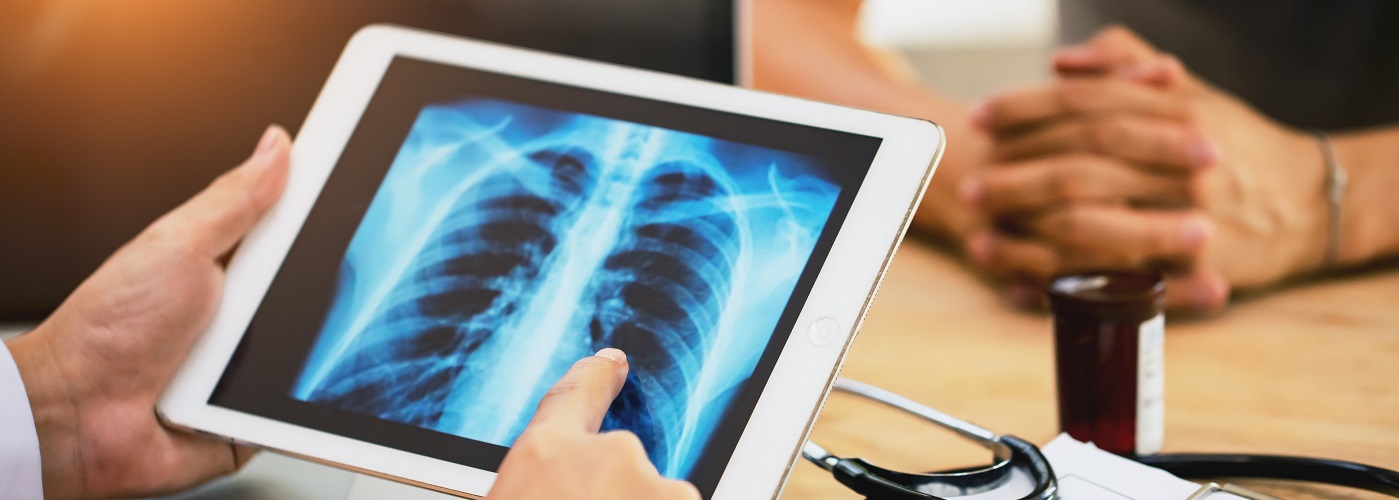Lung cancer starts with abnormal cells growth and division in the lung, leading to the development of a mass or tumour. Smoking is the primary cause of lung cancer, although some lung cancers do not have an identifiable cause.
Lung cancer is a significant cancer for Malaysians, occurring in one in 55 males and one in 135 females in the country. It is also responsible for the most cancer-related deaths in Malaysia.
What are the types of lung cancer?
Lung cancer begins in the lungs or airways (trachea and bronchus) and may spread to the lymph nodes or other organs. This spread of cancer cells from one organ to another is known as metastasis.
Lung cancer can be divided into two main categories:
- Small cell lung cancer (SCLS): This type is less common and develops almost exclusively in heavy smokers.
- Non-small cell lung cancer (NSCLC): Most lung
cancers fall under this category. The main types of NSCLC are
squamous cell carcinoma, adenocarcinoma, and large cell carcinoma.
- Squamous cell carcinoma develops on the cells lining the airways of the lungs. It usually develops near the main airways of the lungs.
- Adenocarcinoma is the more common form of lung cancer, which develops from the mucus-making cells of the lungs.
- Large cell carcinoma can develop anywhere in the lungs and are likely to grow and spread quicker than adenocarcinoma or squamous cell carcinoma.
What causes lung cancer?
Smoking is a major cause of lung cancer. Exposure to second-hand smoke or other pollutants are also known to cause lung cancer. In addition, genetics can also influence the development of lung cancer.
What are the risk factors of developing lung cancer?
The majority of lung cancer cases are caused by smoking. However, those who have never smoked are also susceptible to the disease. Below are a few risk factors that may increase the likelihood of lung cancer:
The single most significant risk factor for lung cancer is smoking cigarettes. It accounts for more than 70% of cases. More than 60 distinct carcinogenic toxins (cancer-producing) can be found in tobacco smoke. More than 90% of men with lung cancer have a history of heavy smoking.
People who smoke cigarettes are 15 to 30 times more likely to develop lung cancer or die from lung cancer than non-smokers. Even a few cigarettes per day or occasional smoking raises the risk of developing lung cancer. The risk increases with the number of years a person has smoked and the quantity of cigarettes smoked daily.
Other forms of tobacco:
- Pipe and cigar smoking: While those who smoke cigarettes are at a greater risk of developing lung cancer, pipe and cigar smokers are at 5 times higher risk than non-smokers.
- Chewing tobacco
- Powdered form of tobacco
What are the signs and symptoms of lung cancer?
Lung cancer may not show recognisable signs and symptoms in its early stages. They are usually more apparent closer to advanced stage. Below are some symptoms of lung cancer:
- Persistent cough
- Coughing up blood
- Shortness of breath
- Chest pain
- Hoarse voice
- Unexplained, rapid weight loss
- Bone pain
- Headache
- Weakness or feeling tired all the time
- New onset of wheezing
- Chest pain that worsens with coughing or laughing
Metastatic lung cancers are typically Stage IV (advanced, extensive-stage cancer), depending on how wide the tumour has grown and spread. Learn more about the symptoms of metastatic lung cancer.
How do doctors diagnose lung cancer?
Diagnosis is made based on various investigations. Your doctor would first question you about your general health and symptoms and may later request blood tests. Investigations include:
The first test usually done to diagnose lung cancer is chest X-ray. In chest imaging, important cues such as apparent mass, the collapse of the lung, and widening of the chest area could suggest lung cancer diagnosis and warrant further investigations.
Lung cancer often appears as a white-grey mass on a chest radiograph, but this can be due to other conditions. Therefore subsequent, more tests are done to confirm the diagnosis.
A computed tomography (CT) scan is typically the subsequent test performed following a chest X-ray. A CT scan creates detailed images of the inside of your body using X-rays and a computer.
Before the CT scan, you will receive an injection containing a specific dye called a contrast medium, which aids in image quality. The procedure is painless and takes between 10 and 30 minutes.
If the CT scan shows an early stage of cancer, a combination of positron emission tomography (PET) scan and CT scan, PET-CT scan can be done.
PET-CT imaging can reveal the location of active cancer cells. This would aid in diagnosis and treatment selection. You will be injected with a mildly radioactive material prior to the PET-CT scan. This procedure is painless and takes between 30 and 60 minutes.
A biopsy is a technique that involves the removal of a sample of abnormal cells. There are several ways of conducting biopsies, including:
- Bronchoscopy to view the interior of your airways using a camera on a thin tube to extract a small sample of cells.
- Mediastinoscopy to examine the area at the centre of your chest between your lungs. This is an invasive test that requires general anaesthesia. Your doctor may also collect samples from your lymph nodes.
- Thoracoscopy to examine and collect tissue and fluid from a specific area of your chest. This procedure is also invasive and requires general anaesthesia.
- Percutaneous needle biopsy is done by using a local anaesthetic to numb the skin. Your doctor will then use a CT scanner to guide a needle through your skin and into your lung, specifically to the suspected location of a tumour. The needle extracts a small sample of tissue from a suspicious tumour for laboratory testing.
Learn more about the different types of screening and diagnostic procedures performed to diagnose lung cancer.
How is lung cancer treated?
The treatment of choice for lung cancer depends on the type of cancer, the tumour's position and size, and the stage of cancer.
Small cell lung cancer is treated with chemotherapy alone or combined with radiotherapy or immunotherapy. Non-small cell lung cancer is usually treated with a combination of surgery and chemotherapy. If your doctor finds you unsuitable for surgery due to your general health, radiotherapy with chemotherapy would be recommended.
The key therapies used are surgery, chemotherapy, radiotherapy, and immunotherapy. However, if cancer has metastasised too far, chemotherapy with or without immunotherapy would be recommended. In cases of a specific mutation, targeted therapy is recommended.
Lung cancer surgery is done to remove the entire tumour and a part of the healthy to avoid the spread of cancer cells. There are 3 types of surgery for lung cancer, namely:
- Lobectomy: Parts of the lung (lobes) are removed
- Pneumonectomy: Total lung removal is performed
- Segmentectomy or wedge resection: A small piece of the lung is removed. Only done in the very early stage of lung cancer
Chemotherapy is a cancer treatment that employs potent cancer-killing medications to reduce the rate of spread of cancer.
It can be given before surgery to shrink tumour size and/or after surgery to destroy the remaining cancer cells. It can also be given in a combination with radiotherapy.
Chemotherapy is usually given in 4 to 6 cycles for 3 to 6 months. It may also be given in a combination of medicines for a better outcome.
Radiation therapy uses high-energy radiation to shrink tumours and destroy cancer cells. Types of radiation therapy are:
- 3-Dimensioned Conformal Radiation Therapy (3DRT): 3DRT uses radiation beams that mimic the shape of the tumour, and this targeting information is used to focus precisely on the tumour thereby avoiding the healthy surrounding tissue.
- Intensity Modulated Radiotherapy (IMRT): IMRT is conformal radiotherapy that uses radiation beams which get divided into small beamlets with varying radiation intensity allowing different doses of radiation to be given across the tumour.
- Volumetric Arc Therapy (VMAT): VMAT is also known as Rapid Arc, involves use of a machine which rotates around the patient in an arc shape. The machine changes the shape and intensity of the beam constantly while moving around the body to improve accuracy and decrease the treatment time.
- Image-Guided Radiotherapy (IGRT): IGRT uses frequent imaging during radiotherapy to improve the precision and accuracy of radiation delivery.
Learn more about the different types of treatment technologies to treat lung cancer.
What can I do to reduce the risk of developing lung cancer?
While not all lung cancers can be prevented, implementing certain lifestyle changes can help reduce the risk of developing lung cancer. Among the changes one can make include:
- Stop smoking: Smoking cessation can reduce the risk of lung cancer, even in long-time smokers. Counselling or support groups, nicotine replacement therapy, or other medications are a few ways that can help curb the smoking habit.
- Avoid second-hand smoke: Second-hand smoke is just as risky as smoking first-hand. Avoid frequenting areas where people smoke.
- Avoid carcinogens and environmental pollutants such as radon and diesel exhaust: Exposure to pollutants at the workplace, for example, might increase the risk of lung cancer. Construction workers, for example, might receive increased exposure to asbestos. One could also get their house be tested for radon.
- Eat a healthy diet: A healthy diet must incorporate plenty of fruits and vegetables. They contain nutrients that are great to offset the pollutants that can harm the body.
- Exercise frequently: Regular exercise helps to keep the body and lungs fit.
How do I get screened for lung cancer?
Lung cancer treatment is more likely to be successful if started from an early stage. In order to detect lung cancer early, lung cancer screening is recommended for current and ex-smokers, even if they don't show any signs or symptoms.
The American Cancer Society recommends yearly screening for the below groups of individuals:
- People aged 50-80 years old and in fairly good health
- Current smokers or ex-smokers who recently quit smoking (within the past 15 years)
- Smokers with at least a 20 pack-year smoking history (number of packs of cigarettes smoked per day multiplied by the number of years smoked)
Screening people with a high risk of lung cancer (due to history of smoking) with spiral CT scans reduces the risk of death in the long-term better than regular chest X-rays.
Make an appointment at Pantai Hospitals
Early detection of lung cancer makes it easier to treat the disease with effective and appropriate treatment. A dedicated multidisciplinary team of specialists and oncologists at Pantai Hospitals is available for consultation to provide the best care and assistance to patients through screening, diagnosis, and treatment.
Get in touch with us to book an appointment today if you have any concerns or questions about lung cancer treatment options.
Pantai Hospitals have been accredited by the Malaysian Society for Quality in Health (MSQH) for its commitment to patient safety and service quality.


 Request an Appointment
Request an Appointment.webp?sfvrsn=276ce14_1/vector-(3).webp) International Patient
International Patient

.webp)

 Find A Doctor
Find A Doctor



.webp?sfvrsn=20763f7d_21)
.webp?sfvrsn=f2a2c343_12)





